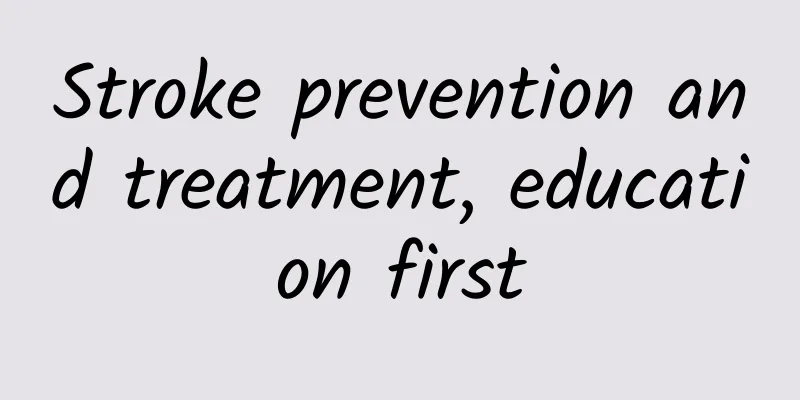Stroke prevention and treatment, education first

|
Stroke, commonly known as "stroke", also known as cerebrovascular accident, includes ischemic stroke and hemorrhagic stroke, which is caused by sudden blockage or rupture of the blood supply artery to the brain. Among them, ischemic stroke (cerebral infarction) accounts for 85%; hemorrhagic stroke includes cerebral hemorrhage (cerebral hemorrhage) and subarachnoid hemorrhage. In order to implement the macro-strategy of "moving the checkpoints forward, sinking the center of gravity; improving literacy, and prioritizing education" for stroke prevention and treatment of the National Brain Protection Committee, through public welfare activities such as the Red Bracelet Spark Project, scientific education on stroke prevention and treatment is carried out through multiple channels to improve the public's understanding of stroke prevention and treatment knowledge, in order to reduce the incidence, disability and mortality of stroke. 1. Raise public awareness of stroke emergency care The treatment effect of stroke is highly time-dependent. If acute stroke patients can receive timely and effective treatment, the mortality and disability rates can be greatly reduced. For ischemic stroke, thrombolytic therapy can make 13% of patients recover quickly and 20% of patients improve significantly; thrombectomy can improve the condition of 50% of patients. Both thrombolysis and thrombectomy have strict time windows. The golden time window for thrombolysis is 3 hours, with a maximum of 6 hours; the best time window for thrombectomy is 6 hours, with a maximum of 24 hours. For every 1 minute of delay, 1.9 million brain cells will die. The current thrombolysis rate for ischemic stroke in my country is only 7%, and 93% of patients have missed the golden time for treatment, so it is crucial to raise public awareness of stroke emergency treatment. 2. Standardize pre-hospital emergency care for stroke Strengthening professional training of emergency personnel on stroke emergency procedures is a necessary prerequisite for improving pre-hospital emergency care for stroke. Emergency personnel should quickly and effectively identify stroke patients, and the 120 emergency center should give priority to dispatching stroke patients. 3. Early recognition of cerebrovascular disease symptoms ① 1-2-0 three-step stroke identification method: "1" means "see 1 face (crooked mouth corner)", "2" means "check both arms (one side cannot be lifted)", and "0" means "listen (zero) to language (unclear speech, big tongue)". If you find any abnormality, call the emergency number 120 immediately. ②FAST rapid assessment: "F" (Face): Ask the patient to smile. If the face is asymmetrical when smiling, it indicates that the patient has facial paralysis. "A" (Arm): Ask the patient to raise both hands horizontally. If one limb falls within 10 seconds, it indicates limb paralysis. "S" (Speech): Ask the patient to say a long sentence. If the patient does not understand, has difficulty speaking, or cannot find words, it indicates a language disorder. "T" (Time): The above symptoms indicate suspected stroke, please call 120 immediately. ③BEFAST quick identification: Balance impairment and visual impairment are added to FAST to avoid missing posterior circulation infarction. "B"-Balance refers to balance: loss of balance or coordination, sudden unsteady walking; "E"-Eyes refers to the eyes: sudden changes in vision, difficulty seeing; “F”, “A”, “S”, and “T” are the same as above. ④ Identification of posterior circulation infarction: Posterior circulation infarction may be life-threatening, but there are few clinical evaluation methods for the posterior circulation, especially when the patient presents with isolated vertigo (without neurological localization symptoms and signs), which makes diagnosis difficult. Detailed questioning of vertigo, diplopia, dysphagia, balance disorders, and auditory symptoms, as well as Horner sign, nystagmus, head impulse test, eye deviation and other examinations can help early diagnosis. IV. Treatment of ischemic stroke 1. Stroke Green Channel Once a stroke is suspected, you must immediately enter the stroke green channel: first treat, then pay; check-up and medication are prioritized. Immediately perform an electrocardiogram, blood routine, blood sugar, and head CT scan. For patients who meet the criteria for intravenous thrombolysis or thrombectomy, treatment should be provided after clear and concise communication with the patient and/or family members. The National Brain Protection Committee requires that the time from the patient's admission to the hospital to the start of intravenous thrombolysis (DNT) in the stroke center be within 60 minutes, and the time from the patient's admission to the hospital to the successful puncture (DPT) for thrombectomy patients must be within 90 minutes. Hospitals without thrombolysis or thrombectomy conditions must transfer patients to stroke centers with conditions as soon as possible. 2. Intravenous thrombolytic therapy is the most effective measure to restore cerebral blood flow. Patients with ischemic stroke who are eligible within 4.5 hours of onset can be treated with recombinant tissue plasminogen activator (rt-PA) (alteplase) and intravenous thrombolysis with urokinase within 6 hours. The European Stroke Organization (ESO) 2021 guidelines for intravenous thrombolysis in acute ischemic stroke recommend extending the time window for intravenous thrombolysis with rt-PA to 4.5-9 hours after onset, but CT or magnetic resonance imaging is required to confirm core/perfusion area mismatch. Outcomes after rt-PA thrombolysis: 13% returned to normal, 20% significantly improved, 65% remained unchanged, 2% worsened, and 1% were severely disabled or died. 3. Emergency endovascular surgery Including bridging, mechanical thrombectomy, angioplasty and stenting, it is used for patients with large vessel disease to achieve vascular recanalization through thrombus aspiration, stent thrombectomy, etc. It can be used in combination with thrombolytic therapy. Patients within 6 hours of onset can undergo bridging (thrombolysis first, then endovascular treatment)/endovascular thrombectomy; patients within 6-24 hours of onset, after multimodal imaging evaluation, can undergo endovascular treatment if they meet the indications. 4. Other acute treatments for ischemic stroke Patients who undergo thrombolysis or thrombectomy should be closely monitored for changes in their condition after surgery, and the National Institutes of Health Stroke Scale (NIHSS) should be scored at time points to assess whether there is reinfarction or bleeding. Regardless of whether thrombolysis or thrombectomy is performed, changes in the patient's symptoms and signs should be closely monitored to prevent and treat possible progressive stroke. In addition to blood pressure and blood sugar management, antiplatelet and lipid-lowering treatments, critically ill patients need to be admitted to the neurology intensive care unit (NICU) to monitor vital signs, reduce intracranial pressure, and prevent and treat complications. Butylphthalide (injection and capsules) and urinary kallidinol can open collateral circulation and protect mitochondria; edaravone can scavenge free radicals and resist excitatory amino acid toxicity. They have all been proven to improve neurological function and prognosis in patients with ischemic stroke. 5. Antiplatelet therapy for patients with non-cardioembolic ischemic stroke Aspirin (50-325 mg/d) or clopidogrel (75 mg/d) can be used as single-agent antiplatelet therapy. Indobufen and cilostazol can be used for patients with high bleeding risk; Patients with mild ischemic stroke should start dual antiplatelet therapy (DAPT) (aspirin 100 mg/d plus clopidogrel 75 mg/d) within 24 hours of onset, and can be switched to single drug after 21 days; Patients with ischemic stroke or transient ischemic attack (TIA) with symptomatic severe intracranial artery stenosis (stenosis rate 70%-99%) within 30 days of onset should be treated with aspirin combined with clopidogrel for 90 days as soon as possible, and then switched to monoclonal antibody treatment; For patients with moderate to high risk of recurrent stroke, DAPT should be initiated within 24 hours of onset and continued for 21 days, and then changed to single-agent clopidogrel 75 mg/d, with a total course of 90 days; then aspirin (100 mg/d) or clopidogrel (75 mg/d) monoclonal antibody should be used long-term. 6. Antithrombotic therapy for patients with cardiogenic stroke For patients with ischemic stroke or TIA accompanied by atrial fibrillation, warfarin or new oral anticoagulants (dabigatran, rivaroxaban, apixaban, etc.) are recommended for treatment to prevent recurrence of thromboembolism. Patients who are not suitable for anticoagulant therapy can choose aspirin (100 mg/d) or clopidogrel (75 mg/d) as antiplatelet therapy. 7. Acute treatment of hemorrhagic stroke After the head CT confirms cerebral hemorrhage or subarachnoid hemorrhage, the patient should be transferred to a neurosurgery or neurology department with treatment conditions as soon as possible. In the acute phase, blood pressure should be controlled and vital signs should be stabilized, the cause should be identified as soon as possible, and conservative or surgical treatment should be adopted according to the condition: Minimally invasive puncture drainage or craniotomy for cerebral hemorrhage; Subarachnoid hemorrhage is treated with endovascular treatment or clipping for causes such as aneurysms to prevent rebleeding, while related complications are actively controlled. 8. Rehabilitation treatment for stroke Rehabilitation training for motor function includes traditional muscle strength training, joint range of motion training, neurophysiological methods, proprioceptive sensory neuromuscular facilitation, as well as constrained movement therapy, weight loss walking training, and motor relearning programs. Sensory disorders: Specific sensory training and sensory association training can be carried out, or transcutaneous electrical stimulation combined with conventional treatment can be used to improve the patient's sensory abilities such as touch and muscle movement perception. Language function: Speech therapists should evaluate stroke patients with communication disorders in terms of listening, speaking, reading, writing, and retelling as early as possible, and provide rehabilitation treatment for speech and semantic disorders. Cognitive and emotional disorders: First, cognitive function can be assessed using the Mini-Mental State Examination (MMSE) and the Montreal Cognitive Assessment (MoCA). Post-stroke anxiety and depression can be screened using the Hamilton Anxiety Rating Scale (HAMA) and the Depression Rating Scale (HAMD). Cholinesterase inhibitors can be used to improve post-stroke cognitive function. Post-stroke emotional disorders can be treated with classic antidepressants such as the selective serotonin reuptake inhibitor citalopram or traditional Chinese medicines such as Shugan Jieyu Capsules and Jieyu Pills, as well as psychotherapy. Swallowing disorders: "Shaker" therapy, thermal tactile stimulation, neuromuscular electrical stimulation and other methods can be used for swallowing function training. For those who cannot maintain adequate nutrition and water through the mouth, enteral nutrition (nasogastric tube, nasointestinal tube or percutaneous endoscopic gastrostomy) should be considered. Urinary and bowel disorders: Using a urinary catheter for more than 48 hours will increase the risk of urinary tract infection, and it is recommended to remove it as soon as possible; if it needs to be continued, it is recommended to use an antibacterial catheter such as a silver alloy coated catheter; it is also necessary to develop and implement bladder and bowel training plans for patients with urinary and bowel disorders. |
Recommend
What to do if your menstrual flow is light? Diet and daily life need to be adjusted
If the menstrual volume is small for a long time,...
What will happen if a woman eats too many crabs?
It is autumn now, so crabs are very suitable for ...
If my period comes on the 15th, what is the ovulation date?
The ovulation period is something that women atta...
Does it hurt to remove the ring? How long does it take?
Removing an IUD requires surgery, and surgery gen...
Why is it that I am bleeding again two days after my period?
Generally, normal adult women have menstruation o...
What can I eat during my period without getting fat?
That is not the case. During menstruation, women&...
Why is black tea sweet and green tea bitter? What kind of green tea tastes light
Green tea is the most produced type of tea in my ...
Is it necessary to drain the residual milk?
Many mothers are giving birth to a child for the ...
What is the reason for scanty menstrual flow?
In the past, friends often said that their menstr...
"Big heart" is also a disease! How to solve the dilated cardiomyopathy known as the "family curse"?
Review expert: Wang Xin, deputy chief physician o...
How to deal with fallopian tube pain?
In life, there are many women who experience fall...
How often should you check during pregnancy?
For pregnant women, every aspect of their body ne...
What is the difference between white chocolate and dark chocolate? What are the functions of white chocolate?
White chocolate is chocolate without cocoa powder...
What to do if placenta remains after delivery?
If some pregnant women have problems, they need t...









